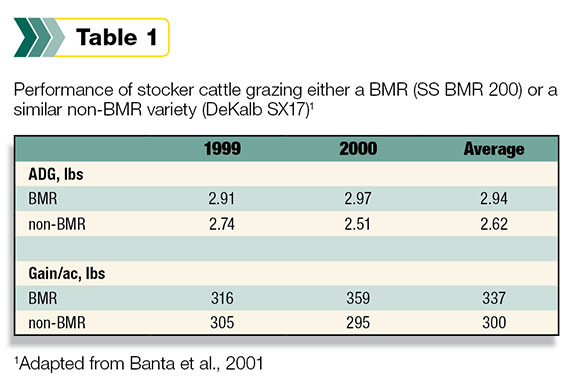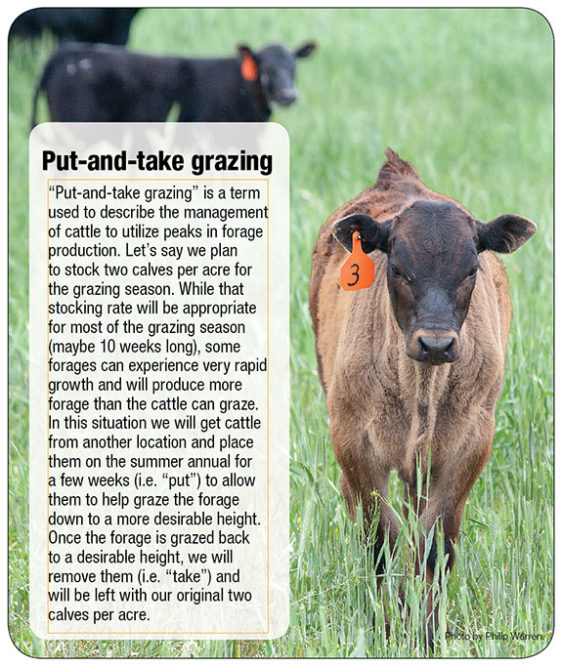The brown mid-rib (BMR) trait refers to a visual characteristic seen in sorghums, sorghum x sudangrass, sudangrass, pearl millet and corn, with light to dark brown coloring.
Forages with the BMR trait are typically higher in digestibility and, thus, energy content, resulting in increased average daily gain (ADG) or milk production for livestock.
The ADG research
Although limited, results from grazing studies comparing the use of BMR forages to genetically similar non-BMR varieties are extremely encouraging.

Table 1 shows results of a grazing study conducted in 1999 and 2000 at the Texas A&M Bush Research Farm located near Amarillo, Texas.
Steers grazing the BMR sorghum x sudangrass hybrid gained 0.32 pounds per day more and also produced 37 pounds more weight gain per acre than those grazing a similar non-BMR variety.
Additional work at A&M with photoperiod-sensitive sorghum x sudangrass hybrids showed a 0.17-pound increase in ADG for steers grazing the BMR hybrid.
Research from the University of Nebraska with grain sorghum stubble has also been positive.
Steers grazing stubble with the BMR gene gained an extra 0.36 pounds per day, which resulted in 23 pounds more gain per acre over a 65-day grazing period.
Another benefit is the increased palatability observed for BMR forages. This increase results in greater utilization of plant stems and also less forage lying on the ground (litter) at the end of the grazing period.
These benefits have resulted in excellent performance of stocker steers at the Bush Research Farm. In replicated trials over a five-year period, ADG of stocker steers grazing BMR sorghum x sudangrass hybrids ranged from 2.44 to 3.04 pounds per day with an average of 2.73 pounds per day. Gain per acre in these studies averaged 364 pounds.
Which BMR should I plant?
Of the forage types with BMR traits, sudangrass, sorghum x sudangrass and pearl millet are most often used in grazing or haying operations. The decision of which of these to plant should be based on soil type, planned use and expected animal performance.
Pearl millet does not pose a risk for prussic acid and can handle more acidic soils than sudangrass and sorghum x sudangrass; however, it tends to be lower in energy content, which would result in lower animal performance.
When deciding between sudangrass and sorghum x sudangrass, make sure to consider seed cost per acre, grazing characteristics and yield potential.
Sudangrass may recover better after multiple grazing events than sorghum x sudangrass. However, if the potential for hay production is also desired, then the sorghum x sudangrass hybrids may provide a yield advantage.
Potential lodging problems and reductions in dry matter yield are concerns some have expressed with BMR forages. Many of the early BMR varieties had problems with lodging, but advances in plant breeding have eliminated almost all problems in grazing situations.
Dry matter yields can be lower for BMR varieties compared with genetically similar non-BMR varieties. However, when pounds of digestible energy per acre and the resulting gain per acre are considered, it is definitely worth giving up a little yield to increase gain or milk production per acre.
In addition to looking for a variety with the BMR trait, there are several other items that should be considered. Not all BMR varieties are created equal; some BMR varieties perform extremely well, while others may not show much improvement compared with non-BMR varieties.
This occurs because there is more than one gene that can produce the visual BMR trait as well as other genetic differences among varieties.
If possible, it is desirable to select a variety with some data behind it. However, rapid advances are being made in forage breeding programs, and as a result, tested varieties may not be available. If varieties with known performance in your region are not available, it would be wise to select more than one variety to plant on your operation.
Numerous varieties of BMR sorghum x sudangrass are available to choose from. In addition to the BMR trait, some are also photoperiod-sensitive. While these varieties excel in yield, ADG and gain per acre have actually been lower for these varieties.
Another trait found in some of the BMR sorghum x sudangrass hybrids is a brachytic dwarf trait characterized by shorter internodes, which results in a greater leaf-to-stem ratio.
Although published research is lacking on these varieties, increasing the leaf-to-stem ratio should result in improved animal performance, and the dwarf BMR varieties definitely deserve a try.
Seed availability
When it comes to sudangrass and pearl millet, the number of varieties available with the BMR trait is limited. To date, all commercially available varieties of BMR sudangrass come from the Cal/West Seeds program in California; these varieties have only been available since 2007.
Additionally, there appear to only be a few varieties of BMR pearl millet commercially available at this time. Two examples include BMR 209 hybrid pearl millet and PM 508/13 sold by Forage First Genetics and Desert Sun Marketing Company Inc., respectively.
Grazing management
Sorghum x sudangrass hybrids, sudangrass and pearl millet have the potential to produce a tremendous amount of growth resulting in high stocking rates.
Unfortunately, this growth is usually not distributed evenly over the grazing season, which can result in stocking rate challenges. Producers need to plan for this and have additional cattle available for put-and-take grazing or consider making hay with extra forage.
From a grazing management standpoint, some people find it beneficial to leave a few unplanted strips about 2 feet to 3 feet wide throughout the field. If electric fences are being utilized, it would also be beneficial to leave a few feet unplanted next to the fence.
Based on the available grazing data, silage studies and variety trials, BMR forages have definitely earned the right for consideration. So the next time you are looking to increase performance and reduce cost of gain, you might want to include a BMR forage in your operation. FG













